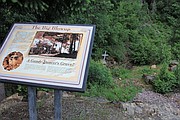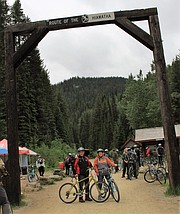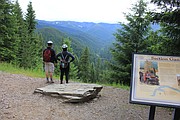'The crown jewel of all trail-rail adventures'
Kathleen Woodford Mineral Independent | Hagadone News Network | UPDATED 7 years, 6 months AGO
Tunnel 20 is an ominous, dark hole that swallows up bikers for 1.8 miles and is called the Taft Tunnel. It’s one of eight tunnels that stretch along the 15-mile Route of the Hiawatha bike trail. The sound of bikers echo off the cement walls that drip with water, and the air is cold and damp. There is a crown in the center of the tunnel, and ditches along the sides needed to drain water that runs at 3,000 gallons per minute.
Once bikers make their way through Tunnel 20, there are seven more tunnels, along with seven high steel trestles. The Route of the Hiawatha bike trail is a part of the old Chicago, Milwaukee, St. Paul and Pacific Railroad, which was originally built in 1847. However, a bankruptcy in 1980 caused the company to abandon its Pacific extension through Montana, Idaho and Washington, and the route was abandoned.
In the 1990s, the Taft Tunnel Preservation Society had a vision of creating the now-popular bike trail, which opened to the public in 1998. On Saturday, June 23, a 20-year celebration was held at the east portal of the trail where more than 50 people showed up to commemorate this amazing accomplishment called the “Crown Jewel” by the Rails to Trails Conservancy. The celebration also recognized the 50th Anniversary of the National Trails System Act. Forest Service personnel, representatives from congressional offices, media outlets, and people who created and work to keep the trail operating were there as part of a ceremony held at 10 a.m. on June 23.
After the ceremony, over half of them accepted the offer of a complimentary bike ride on the trail - which winds down through the St. Joe Ranger District of the Idaho Panhandle National Forests, and straddles the Idaho/Montana state line in the Bitterroot Mountains. At the end of the ride, shuttles were available to take riders back to their vehicles parked at the Lookout Ski Area located at exit 0 on the Montana/Idaho state border of Interstate 90.
A few individuals were honored with plaques for their participation in making the trail a success, including Dave Reichert, the Idaho Panhandle Forest Service supervisor. Other people were recognized for their various efforts to make the trail a success, including Jamie Schmidt of the Taft Tunnel Preservation Society, Bill Dwyer, Bill Alderidge, Jim Fowler, Idaho U.S. Sen. Larry Craig, and Diane Norton, president of the Lookout Associates LLC. Phil Edholm also gave remarks at the ceremony. Lookout Associates is the parent company of the Lookout Pass Ski and Recreation Area; it holds the license for the Route of the Hiawatha.
“The Route of the Hiawatha is the crown jewel of all trail-rail adventures in the country,” Edholm said to the crowd. “It is an outstanding example of a public and private partnership, and helps to stimulate the local recreational economy and tourism.”
When the trail first opened in 1998, they had 8,600 riders and now boasts over 44,000 riders annually. “Over half a million users have enjoyed the trail and over $4 Million in tourism dollars are spent annually as a result,” he said.
Starting with one bus
When it first started, Lookout Associates employed seven people and operated one bus. Now, there are 60 full- and part-time employees with 10 busses that run daily. Edholm also talked about the necessity to continue to raise funds for maintenance of the aging tunnels and trestles, which are slowly deteriorating and will require hundreds of thousands of dollars to maintain.
The tunnels on the trail are numbers 20 through 27, and vary in length. They are numbered with the miles from Seattle to Chicago, which was the original railroad route when the line was built in the 1890s. Shauna Hillman, director of the Northern Pacific Railroad Museum in Wallace, Idaho, gave a brief history of the railroad. The Hiawatha, which gives the trail its name, were famous high-speed trains, which exceeded 100 mph. The Olympian Hiawatha was a premier luxury limited passenger train, which began running in 1947.
Unfortunately, the railroad line was plagued with problems from the beginning. During its original construction, the estimated costs to build it in 1905 was $60 million. However, when it was completed in 1909, the final figure was $257 million. Then a historic fire of 1910 ravaged the line, which resulted in costly repairs. In 1914, a 3,000-volt direct current overhead system was built and trains traveled 438 miles by electricity. The depression hit shortly afterwards, and the company declared bankruptcy in 1925. They declared bankruptcy again in 1935, and a final time in 1974. In 1980, salvage companies came in and stripped the site of all that was valuable and removable.
Historic signs mark trail
Now, the Hiawatha trail is marked with numerous historic signs as riders view the expansive forests and cross high steel trestles. The highest one, called the mighty Kelly Creek Trestle, is 230 feet high and 850 feet long. The trail also winds past a single grave where The Gandy Dancer is buried. Gandy dancers were crews that would work in unison to put the rails back in place using a gandy tool. Legend states that during the 1910 fires engineers were evacuating towns and camps along the tracks, and then took shelter in the tunnels as the blaze roared past. One individual panicked during the evacuation and jumped off the train and died. He was buried next to the track with his grave marked by a large, white cross.
Several towns dotted the area when the railroad was being built and was in operation, including the rowdy town of Taft, as well as Roland, and Adair. Now, only cement foundations mark where some of the buildings once stood to remind people of their foot print in history.
The Route of the Hiawatha runs from May until September 23, and bikers can purchase tickets for $11 to ride the trail. Bikes and equipment rentals are also available. Passes can be purchased at the ski resort as well as at the east portal located at the Taft exit.
ARTICLES BY KATHLEEN WOODFORD MINERAL INDEPENDENT
Mineral County sends tax bill to Forest Service
The Forest Service will be receiving a property tax bill from Mineral County this year. County Commissioners Laurie Johnston, Roman Zylawy and Duane Simons signed the letter March 9 requesting property tax revenue for 2017. The “historic letter” as defined by Rep. Denley Loge, describes the plight Mineral County is facing as options to fund the county have dried up.
Colorado woman dies after vehicle gets stuck
An early evening call received by Mineral County dispatch on Friday, March 17, ended in tragedy. The body of Colorado resident Debra Ann Koziel was found in the Fish Creek area by a search team the following Tuesday afternoon. Her death was determined to be the result of exposure to weather.

No major flooding as snow thaws
“As the ground starts thawing, the rocks start falling,” was a post made on the Mineral County Sheriff’s Office’s Facebook page last week. A photo accompanied the post of a big rock which had come down on Mullan Road East near the Big Eddy fishing access in Superior on March 11. “Please be aware of your surroundings and pay attention while driving,” they warned in the post.











